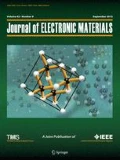Abstract
The stress–strain response of miniaturized Sn-Ag-Cu (SAC) lead-free solder joints in the thickness range of 80 μm to about 1.1 mm was studied. A high-resolution three-dimensional (3D) digital image correlation system was used for in situ measurement of displacement and strain fields in the solder joints during tensile testing. These measurements showed that the localization of plastic strain and stress buildup occurs mainly at the interface of the solder. With increasing solder gap thickness the size of the plastically deformed zone in the solder increases, resulting in transformation of a brittle interfacial fracture to a ductile fracture within the bulk of the solder. The experimental deformation plots of solder joints and strain-rate-dependent tensile tests on bulk solder material were used to establish a new constitutive material model for the solder. This strain-rate- and pressure-dependent material model was implemented in ABAQUS through the user subroutine CREEP. In agreement with the experiments, the finite-element method simulation revealed a pronounced thickness effect leading to higher tensile strength of thinner solder joints.
Similar content being viewed by others
References
K.N. Subramanian, eds., Reliability of Lead-Free Electronic Solder Interconnects (Chichester, UK: Wiley, 2012).
C. Schmetterer, H. Ipser, and J. Pearce, eds., Handbook of Properties of SAC Solders and Joints, ELFNET-COST 531, Vol. 2 (Brussels, Belgium: COST Office, 2008).
Z. Huang, P. Conway, E. Jung, R. Thomson, C. Liu, T. Loeher, and M. Minkus, J. Electron. Mater. 35, 1761–1772 (2006).
P. Zimprich, U. Saeed, A. Betzwar-Kotas, G. Khatibi, B. Weiss, and H. Ipser, J. Mater. Sci.: Mater. Electron. 19, 383–388 (2008).
J. Cugnoni, J. Botsis, V. Sivasubramaniam, and J. Janczak-Rusch, Fatigue Fract. Eng. Mater. Struct. 30, 387–399 (2006).
A.D. Kammers and S. Daly, Meas. Sci. Technol. 22, 125501 (2011).
T.T. Nguyen, D. Yu, and S.B. Park, J. Electron. Mater. 40, 1409–1415 (2011).
S. Yaofeng and J.H.L. Pang, Microelectron. Reliab. 48, 310–318 (2008).
N. Shishido et al., Proceedings 11th International. Conference Electronic Packaging Technology & High Density Packaging, pp 376–381 (2011).
M. Amagai, M. Watanabe, M. Omiya, K. Kishimoto, and T. Shibuya, Microelectron. Reliab. 42, 951–966 (2002).
L. Anand, Int. J. Plast. 1, 213–231 (1985).
X. Chen, G. Chen, and M. Sakane, Proceedings of Intersociety Conference Thermal and Thermomechanical Phenomena in Electronic Systems vol. 2 (2004), p. 447.
Y. Bai and T. Wierzbicki, Int. J. Plast. 24, 1071–1096 (2008).
D.C. Drucker and W. Prager, Q. Appl. Math. 10, 157–165 (1952).
W.A. Spitzig and O. Richmond, Acta Metall. 32, 457–463 (1984).
J.R. Rice and D.M. Tracey, J. Mech. Phys. Solids 17, 201–217 (1969).
M. Lederer, G. Khatibi, B. Weiss, Chemi. Month. 143, 1335–1339 (2012).
Author information
Authors and Affiliations
Corresponding author
Rights and permissions
About this article
Cite this article
Khatibi, G., Lederer, M., Byrne, E. et al. Characterization of Stress–Strain Response of Lead-Free Solder Joints Using a Digital Image Correlation Technique and Finite-Element Modeling. J. Electron. Mater. 42, 294–303 (2013). https://doi.org/10.1007/s11664-012-2276-2
Received:
Accepted:
Published:
Issue Date:
DOI: https://doi.org/10.1007/s11664-012-2276-2




